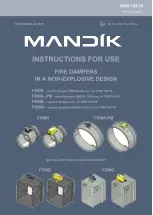
13
The dampers must be installed in compliance with all applicable safety standards and regulations.
Prior to commissioning the dampers and during subsequent serviceability checks, all versions,
including the operation of electrical components, must be inspected and functionally tested, and
the conductive connections of all moving and fixed parts (inside and outside the damper) must
be checked on the damper. After commissioning, these serviceability checks must be performed
at least twice annually. If no fault is found during two consecutive serviceability checks, then it is
possible to carry out serviceability checks once a year.
In the event that, for any reason, the dampers are found unfit to perform their function, this must
be clearly indicated. The operator is obliged to ensure that the damper is brought into a state
where it is able to perform its function again and during this time must provide fire protection in
another sufficient way.
The results of regular inspections, deficiencies found and all important facts concerning the
dampers function must be entered in the "FIRE BOOK" and reported to the operator immediately.
Flange and bolt connections must be conductively connected during installation in accordance
with EN 332000-4-41, -4-47 and -5-54 for protection against dangerous contact. For conductive
connections, 2 pieces of fan-shaped washers in galvanised design are used, which are placed
under the head of one bolt and under the screwed-on nut.
Installation, maintenance and serviceability checks of dampers may only be performed by
persons qualified for these activities, i.e. "AUTHORISED PERSONS" trained by the manufacturer.
The training is performed by MANDÍK, a.s. and issues a "CERTIFICATE" of professional compe-
tence, which is valid for 5 years and its extension is ensured by the "AUTHORISED PERSON"
themselves, directly with the trainer.
Upon the expiry of the validity of the "CERTIFICATE", it loses its validity and is excluded from the
trainer's registration.
Only professionals who take over the warranty for the work performed may be trained.
Prior to commissioning dampers after installation and during subsequent serviceability checks,
the following checks must be carried out:
of a damper's correct installation, the damper's internal space, the damper
leaf, the bearing surfaces of the leaf and the silicone seal.
loosen the cover by turning the wing nut and release
it from the locking bracket by moving the cover left or right. Then tilting and removing the cover
from its original position. In the case of a screw cap, loosen and remove the screws with washers
and remove the cap cover.
• Checking the thermal fuse of the drive - the drive must be removed.
• Checking damper closing - pressing the release button on the mechanism will release the
closing mechanism and move the sheet to the "CLOSED" position. The closing must be
vigorous, the leaf must be in the "CLOSED" position on the stops. If the damper closure is not
strong enough or the leaf is not in the "CLOSED" position, the mechanism must be replaced.
• The damper leaf is moved to the "OPEN" position by the mechanism's lever to the second
extreme position, where it must be locked.
• Inspection of the leaf movement to the emergency position "CLOSED" is performed after the
power supply to the servo-drive is interrupted (e.g. by pressing the reset button on the
thermoelectric starting device, by interrupting the power supply from the EFS).
• The check for moving the leaf back to the "OPEN" position is performed after the supply voltage
has been restored (e.g. by releasing the reset button, restoring the power supply from the EFS).
For reliable operation of dampers, care must be taken to ensure that the closing mechanism and
the bearing surfaces of the leaf are not clogged with dust deposits, fibrous or sticky substances
and solvents.
Summary of Contents for FDMR
Page 1: ......














